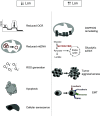Mitochondrial Lon protease at the crossroads of oxidative stress, ageing and cancer
- PMID: 26363553
- PMCID: PMC11113732
- DOI: 10.1007/s00018-015-2039-3
Mitochondrial Lon protease at the crossroads of oxidative stress, ageing and cancer
Abstract
Lon protease is a nuclear DNA-encoded mitochondrial enzyme highly conserved throughout evolution, involved in the degradation of damaged and oxidized proteins of the mitochondrial matrix, in the correct folding of proteins imported in mitochondria, and in the maintenance of mitochondrial DNA. Lon expression is induced by various stimuli, including hypoxia and reactive oxygen species, and provides protection against cell stress. Lon down-regulation is associated with ageing and with cell senescence, while up-regulation is observed in tumour cells, and is correlated with a more aggressive phenotype of cancer. Lon up-regulation contributes to metabolic reprogramming observed in cancer, favours the switch from a respiratory to a glycolytic metabolism, helping cancer cell survival in the tumour microenvironment, and contributes to epithelial to mesenchymal transition. Silencing of Lon, or pharmacological inhibition of its activity, causes cell death in various cancer cells. Thus, Lon can be included in the growing class of proteins that are not responsible for oncogenic transformation, but that are essential for survival and proliferation of cancer cells, and that can be considered as a new target for development of anticancer drugs.
Keywords: Hypoxia; LONP1; Mitochondria; Pim1; mtDNA.
Figures



Similar articles
-
Mitochondrial Lon Protease and Cancer.Adv Exp Med Biol. 2017;1038:173-182. doi: 10.1007/978-981-10-6674-0_12. Adv Exp Med Biol. 2017. PMID: 29178076 Review.
-
Upregulation of the mitochondrial Lon Protease allows adaptation to acute oxidative stress but dysregulation is associated with chronic stress, disease, and aging.Redox Biol. 2013 Feb 9;1(1):258-64. doi: 10.1016/j.redox.2013.01.015. Redox Biol. 2013. PMID: 24024159 Free PMC article. Review.
-
The peroxisomal Lon protease LonP2 in aging and disease: functions and comparisons with mitochondrial Lon protease LonP1.Biol Rev Camb Philos Soc. 2017 May;92(2):739-753. doi: 10.1111/brv.12253. Epub 2016 Feb 8. Biol Rev Camb Philos Soc. 2017. PMID: 26852705 Free PMC article. Review.
-
Overexpression of Lon contributes to survival and aggressive phenotype of cancer cells through mitochondrial complex I-mediated generation of reactive oxygen species.Cell Death Dis. 2013 Jun 20;4(6):e681. doi: 10.1038/cddis.2013.204. Cell Death Dis. 2013. PMID: 23788038 Free PMC article.
-
Silencing of mitochondrial Lon protease deeply impairs mitochondrial proteome and function in colon cancer cells.FASEB J. 2014 Dec;28(12):5122-35. doi: 10.1096/fj.14-255869. Epub 2014 Aug 25. FASEB J. 2014. PMID: 25154874
Cited by
-
Long-term depletion of cereblon induces mitochondrial dysfunction in cancer cells.BMB Rep. 2021 Jun;54(6):305-310. doi: 10.5483/BMBRep.2021.54.6.218. BMB Rep. 2021. PMID: 33408001 Free PMC article.
-
The Protease Locus of Francisella tularensis LVS Is Required for Stress Tolerance and Infection in the Mammalian Host.Infect Immun. 2016 Apr 22;84(5):1387-1402. doi: 10.1128/IAI.00076-16. Print 2016 May. Infect Immun. 2016. PMID: 26902724 Free PMC article.
-
Posttranslational control of the scaffold for Fe-S cluster biogenesis as a compensatory regulatory mechanism.Curr Genet. 2017 Feb;63(1):51-56. doi: 10.1007/s00294-016-0618-y. Epub 2016 May 31. Curr Genet. 2017. PMID: 27246605 Free PMC article. Review.
-
Akt phosphorylation of mitochondrial Lonp1 protease enables oxidative metabolism and advanced tumor traits.Oncogene. 2019 Oct;38(43):6926-6939. doi: 10.1038/s41388-019-0939-7. Epub 2019 Aug 12. Oncogene. 2019. PMID: 31406245 Free PMC article.
-
Impaired Mitochondrial Morphology and Functionality in Lonp1wt/- Mice.J Clin Med. 2020 Jun 8;9(6):1783. doi: 10.3390/jcm9061783. J Clin Med. 2020. PMID: 32521756 Free PMC article.
References
Publication types
MeSH terms
Substances
LinkOut - more resources
Full Text Sources
Other Literature Sources
Medical

